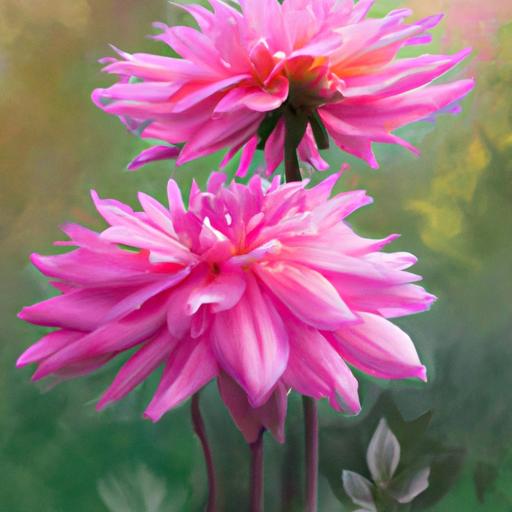If youre looking to add a splash of color and beauty to your garden, why not consider dahlias? Dahlias are an eye-catching and versatile flower that come in a variety of colors and sizes.
But whats the difference between dahlia seeds and tubers? In this article, well discuss the key differences between dahlia seeds and tubers and how to properly plant them.
Well also cover the advantages of both planting methods.
So if youre ready to get started, lets explore the wonderful world of dahlias!
Table of Contents
Short Answer
Dahlias can be propagated both from seeds and tubers.
Seeds are typically started indoors and planted outdoors after the last frost in the spring.
Tubers are planted directly in the soil in the spring.
Dahlia tubers can be divided and replanted every few years, while dahlia seeds need to be started from scratch each year.
The flowers produced from a tuber will be identical to the parent plant, while the flowers from a seed may be different.
Overview of Dahlias
Dahlias are a vibrant and popular flower that is widely grown in gardens around the world.
They come in a variety of vibrant colors and sizes, from small and delicate pom-poms to large, showy dinnerplate varieties.
These flowers are easy to care for and can add a bright pop of color to any garden.
Although they are relatively easy to care for, understanding the difference between dahlia seeds and tubers can be confusing.
Dahlia seeds are small, black, and round, while dahlia tubers are more like potatoes and have multiple eyes.
Understanding the difference between these two is important for successful dahlia cultivation.
When starting dahlias from seed, they should be soaked overnight before planting.
This helps soften the hard outer shell and gives the seeds a better chance of germinating.
Dahlia tubers, on the other hand, should be planted in the late spring in well-drained soil.
Tubers tend to bloom sooner and more reliably than seeds, but seeds are cheaper and can be used to create new varieties of dahlias.
It is also important to note that dahlia tubers are perennials and can be left in the ground, whereas dahlia seeds are annuals and must be replanted each year.
Furthermore, dahlia tubers can be divided and replanted, while dahlia seeds must be started from scratch each year.
Overall, understanding the difference between dahlia seeds and tubers is important for successful dahlia cultivation.
Seeds are cheaper and can be used to create new varieties of dahlias, while tubers are more reliable and can be divided and replanted.
With the right care, dahlias will add a vibrant and colorful touch to any garden.
What are Dahlia Seeds?

Dahlia seeds are small, black, and round, and they are the most popular way to grow dahlias in the garden.
They can be planted directly in the soil, but they should be soaked overnight first to aid in germination.
These seeds are relatively inexpensive, and they can be used to create new varieties of dahlias.
But while the seeds are easy to come by and often take less time to grow, they are not as reliable as dahlia tubers, and they may take longer to bloom and produce flowers.
What are Dahlia Tubers?
Dahlia tubers are storage organs that contain the energy needed for a new plant to grow.
They look like small potatoes or rhizomes and are usually planted directly into the garden in the late spring.
Dahlia tubers have multiple eyes, or points of growth, and can be divided, allowing for more plants to be grown from a single tuber.
When planting dahlia tubers, they should be placed into the soil with the eyes facing upwards and covered with a few inches of soil.
The soil should be well-drained and in an area that receives at least six hours of sunlight a day.
Tubers tend to bloom sooner and more reliably than seeds, making them a popular choice for gardeners.
How to Plant Dahlia Seeds

Planting dahlia seeds is a great way to get started with growing these beautiful flowers.
When it comes to dahlia seeds, there are a few important things to keep in mind.
First and foremost, dahlia seeds are extremely small and require special care.
To ensure a successful crop, it is best to soak the seeds overnight in water before planting.
This will soften the seed coat and allow for easier germination.
Once the seeds have been soaked, they can be planted in well-drained soil.
It is important to make sure the soil is not overly wet, as this can cause the seeds to rot.
Plant the seeds in a shallow furrow, and then cover with a thin layer of soil.
It is important to keep the soil lightly moist until the seeds have germinated.
Once the dahlia seedlings have emerged, they should be thinned to the desired spacing.
To ensure a healthy and strong crop, the plants should be fertilized and watered regularly throughout the growing season.
By following these simple steps, you will be well on your way to growing a beautiful and bountiful crop of dahlias.
How to Plant Tubers
When planting dahlia tubers, the key is to ensure that they are planted in well-drained soil.
If the soil is too wet or not well-drained, the tubers may rot or not grow as well.
To ensure the best results, it’s best to dig down about six to eight inches and mix in compost or other organic matter to improve drainage.
Once the soil is prepared, place the tubers in the ground, with the eyes (the small indentations on the tuber) facing up.
Cover the tubers with at least two inches of soil and press down lightly to make sure they are in contact with the soil.
Water the soil until it is saturated and then wait for the dahlias to begin to sprout.
Once the dahlias have sprouted, it’s important to monitor the soil conditions to make sure they have enough moisture.
Dahlias need consistent moisture in order to thrive, so it’s best to water them regularly (about once a week).
If the soil is allowed to dry out, the tubers may not bloom as expected.
Finally, when the dahlias are in full bloom, it’s important to deadhead the flowers to encourage new growth.
Deadheading is the process of removing the spent flowers from the plant.
This will help the plant to produce healthier and more vibrant blooms throughout the season.
Advantages of Dahlia Seeds

When it comes to the difference between dahlia seeds and tubers, one of the biggest advantages of dahlia seeds is the cost.
Dahlia seeds are often significantly cheaper than tubers, making them an ideal choice for gardeners on a budget.
Additionally, dahlia seeds provide gardeners with the opportunity to create new varieties of dahlias.
As dahlias are cross-pollinated, it is possible to combine the genetics of two different varieties to create something new and unique.
This is a great way to explore the possibilities of dahlia breeding and get creative with your garden.
Another advantage of dahlia seeds is that they are relatively easy to start.
Unlike tubers, which require special care and attention, dahlia seeds can be planted directly in the ground.
The only preparation required is to soak the seeds overnight before planting, which helps them to germinate more quickly.
Dahlia seeds also tend to be more forgiving when it comes to mistakes, such as over-watering or planting too deep, as they are more resilient than tubers.
Finally, dahlia seeds are a great choice for gardeners who want to get a jump start on the growing season.
As dahlia seeds are planted earlier than tubers, they can give gardeners a head start on their dahlia blooms.
This is especially helpful for gardeners in areas with shorter growing seasons, as it allows them to maximize their blooms before the first frost.
Advantages of Tubers
When it comes to dahlia cultivation, tubers have several advantages over seeds.
First, dahlia tubers are much easier to plant than seeds.
Whereas seeds need to be soaked overnight before planting, tubers can simply be planted in the late spring in well-drained soil and will begin to bloom sooner and more reliably than seeds.
Additionally, because tubers are more mature than seeds, they tend to have a higher success rate in terms of germination and flowering.
Tubers are also easier to store, as they can be dug up after the growing season and replanted the following spring.
In terms of variety, tubers can produce a wide range of flower colors, shapes, and sizes.
This makes them a great choice for gardeners who want to create a unique and diverse garden.
As an added bonus, tubers are often less expensive than seeds, making them a cost-effective option for gardeners on a budget.
Finally, tubers are great for propagation.
When planted in the spring, tubers can produce multiple blooms throughout the season.
Furthermore, tubers can be divided and replanted, allowing gardeners to increase their stock of dahlias with minimal effort.
Final Thoughts
Dahlia seeds and tubers offer different advantages when it comes to growing these popular flowers.
While tubers tend to bloom sooner and more reliably than seeds, seeds are cheaper and can be used to create new varieties.
Now that you understand the difference between dahlia seeds and tubers, why not try growing some of each and see which works best for you? You’ll be amazed at the beautiful blooms you can produce!

